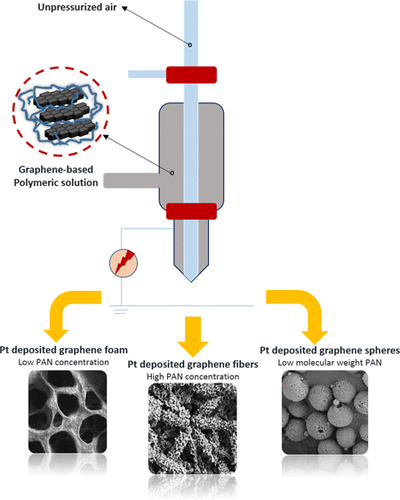Our official English website, www.x-mol.net, welcomes your feedback! (Note: you will need to create a separate account there.)
Design of Pt-Supported 1D and 3D Multilayer Graphene-Based Structural Composite Electrodes with Controlled Morphology by Core–Shell Electrospinning/Electrospraying
ACS Omega ( IF 4.1 ) Pub Date : 2018-06-14 00:00:00 , DOI: 10.1021/acsomega.8b00387 Leila Haghighi Poudeh , Dilek Cakiroglu , Fevzi Çakmak Cebeci , Mehmet Yildiz 1 , Yusuf Z. Menceloglu 1 , Burcu Saner Okan 1
ACS Omega ( IF 4.1 ) Pub Date : 2018-06-14 00:00:00 , DOI: 10.1021/acsomega.8b00387 Leila Haghighi Poudeh , Dilek Cakiroglu , Fevzi Çakmak Cebeci , Mehmet Yildiz 1 , Yusuf Z. Menceloglu 1 , Burcu Saner Okan 1
Affiliation

|
Platinum (Pt)-decorated graphene-based carbon composite electrodes with controlled dimensionality were successfully fabricated via core–shell electrospinning/electrospraying techniques. In this process, multilayer graphene sheets were converted into the three different forms, fiber, sphere, and foam, by tailoring the polymer concentration, molecular weight of polymer, and applied voltage. As polymer concentration increased, continuous fibers were produced, whereas decreasing polymer concentration caused the formation of graphene-based foam. In addition, the reduction in polymer molecular weight in electrospun solution led to the creation of three-dimensional (3D) spherical structures. In this work, graphene-based foam was produced for the first time by utilizing core–shell electrospraying technology instead of available chemical vapor deposition techniques. The effect of morphologies and dimensions of carbonized graphene-based carbon electrodes on its electrochemical behavior was investigated by cyclic voltammetry and galvanostatic charge–discharge methods. Among the three different electrodes, Pt-supported 3D graphene-based spheres showed the highest specific capacitance of 118 F/g at a scan rate of 1 mV/s owing to the homogeneous decoration of Pt particles with a small diameter of 4 nm on the surface. After 1000 cycles of charging–discharging, Pt-decorated graphene-based structures showed high cyclic stability and retention of capacitance, indicating their potential as high-performance electrodes for energy storage devices.
中文翻译:

核壳电纺/电刷法设计可控制形貌的Pt支撑的1D和3D多层石墨烯基结构复合电极
通过核-壳电纺丝/电喷雾技术成功地制造了具有可控尺寸的铂(Pt)修饰的石墨烯基碳复合电极。在此过程中,通过调整聚合物浓度,聚合物分子量和施加电压,可以将多层石墨烯片转变为三种不同形式,即纤维,球体和泡沫。随着聚合物浓度的增加,产生了连续纤维,而降低的聚合物浓度导致了石墨烯基泡沫的形成。此外,电纺溶液中聚合物分子量的降低导致了三维(3D)球形结构的产生。在这项工作中,石墨烯基泡沫是通过利用核-壳电喷雾技术代替现有的化学气相沉积技术而首次生产的。通过循环伏安法和恒电流充放电方法研究了碳化石墨烯基碳电极的形貌和尺寸对其电化学行为的影响。在三种不同的电极中,Pt负载的3D石墨烯基球在1 mV / s的扫描速率下显示出118 F / g的最高比电容,这是由于在电极上均匀地装饰了直径为4 nm的小直径Pt颗粒。表面。经过1000次充放电循环后,Pt装饰的基于石墨烯的结构显示出高的循环稳定性和电容保持能力,表明它们作为储能设备高性能电极的潜力。通过循环伏安法和恒电流充放电方法研究了碳化石墨烯基碳电极的形貌和尺寸对其电化学行为的影响。在三种不同的电极中,Pt负载的3D石墨烯基球在1 mV / s的扫描速率下显示出118 F / g的最高比电容,这是由于在电极上均匀地装饰了直径为4 nm的小直径Pt颗粒。表面。经过1000次充放电循环后,Pt装饰的基于石墨烯的结构显示出高的循环稳定性和电容保持能力,表明它们作为储能设备高性能电极的潜力。通过循环伏安法和恒电流充放电方法研究了碳化石墨烯基碳电极的形貌和尺寸对其电化学行为的影响。在三种不同的电极中,Pt负载的3D石墨烯基球在1 mV / s的扫描速率下显示出118 F / g的最高比电容,这是由于在电极上均匀地装饰了直径为4 nm的小直径Pt颗粒。表面。经过1000次充放电循环后,Pt装饰的基于石墨烯的结构显示出高的循环稳定性和电容保持能力,表明它们作为储能设备高性能电极的潜力。
更新日期:2018-06-14
中文翻译:

核壳电纺/电刷法设计可控制形貌的Pt支撑的1D和3D多层石墨烯基结构复合电极
通过核-壳电纺丝/电喷雾技术成功地制造了具有可控尺寸的铂(Pt)修饰的石墨烯基碳复合电极。在此过程中,通过调整聚合物浓度,聚合物分子量和施加电压,可以将多层石墨烯片转变为三种不同形式,即纤维,球体和泡沫。随着聚合物浓度的增加,产生了连续纤维,而降低的聚合物浓度导致了石墨烯基泡沫的形成。此外,电纺溶液中聚合物分子量的降低导致了三维(3D)球形结构的产生。在这项工作中,石墨烯基泡沫是通过利用核-壳电喷雾技术代替现有的化学气相沉积技术而首次生产的。通过循环伏安法和恒电流充放电方法研究了碳化石墨烯基碳电极的形貌和尺寸对其电化学行为的影响。在三种不同的电极中,Pt负载的3D石墨烯基球在1 mV / s的扫描速率下显示出118 F / g的最高比电容,这是由于在电极上均匀地装饰了直径为4 nm的小直径Pt颗粒。表面。经过1000次充放电循环后,Pt装饰的基于石墨烯的结构显示出高的循环稳定性和电容保持能力,表明它们作为储能设备高性能电极的潜力。通过循环伏安法和恒电流充放电方法研究了碳化石墨烯基碳电极的形貌和尺寸对其电化学行为的影响。在三种不同的电极中,Pt负载的3D石墨烯基球在1 mV / s的扫描速率下显示出118 F / g的最高比电容,这是由于在电极上均匀地装饰了直径为4 nm的小直径Pt颗粒。表面。经过1000次充放电循环后,Pt装饰的基于石墨烯的结构显示出高的循环稳定性和电容保持能力,表明它们作为储能设备高性能电极的潜力。通过循环伏安法和恒电流充放电方法研究了碳化石墨烯基碳电极的形貌和尺寸对其电化学行为的影响。在三种不同的电极中,Pt负载的3D石墨烯基球在1 mV / s的扫描速率下显示出118 F / g的最高比电容,这是由于在电极上均匀地装饰了直径为4 nm的小直径Pt颗粒。表面。经过1000次充放电循环后,Pt装饰的基于石墨烯的结构显示出高的循环稳定性和电容保持能力,表明它们作为储能设备高性能电极的潜力。



























 京公网安备 11010802027423号
京公网安备 11010802027423号